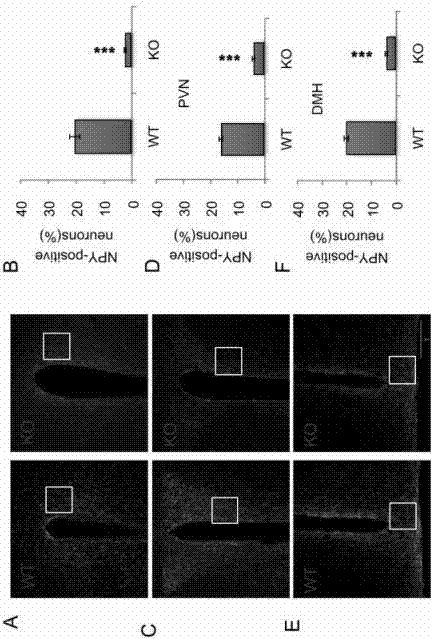Applications of inhibition of Dcf1 gene expression in preparing drugs used for treating obesity
A dcf1, inhibition technology, applied in the application field of inhibiting the expression of Dcf1 gene in the preparation of obesity treatment drugs, can solve the problems of fat-soluble vitamin deficiency and other problems
- Summary
- Abstract
- Description
- Claims
- Application Information
AI Technical Summary
Problems solved by technology
Method used
Image
Examples
Embodiment 1
[0012] Example 1: All experiments were performed in male mice (maintained on a C57BL / 6J background). After the animal is born, dcf1 - / - and dcf1 + / + mice were reared individually in the third week and maintained 12 hours of light (06:00-18:00) and 12 hours of darkness (18:00-06:00), and controlled temperature (24±1°C). Food and water were available ad libitum and sufficient. All animal handling was performed in accordance with Society for Neuroscience guidelines. Three-month-old size comparison see ( figure 1 A), the results of body weight and diet are shown in ( figure 1 B, 1C). (n=28, *P<0.05; **P<0.01; *P<0.001).
Embodiment 2
[0013] Example 2: Take out the target area, hypothalamus, hippocampus and cortex from the pre-cooled PBS. Then homogenize in a homogenizer with Western and IP cell lysate until there is no obvious tissue block and it becomes a transparent homogenate. Continue to lyse on ice for 30 min, and then collect the lysate in a 1.5ml EP tube. The supernatant was collected by centrifugation at 8000 rpm for 10 minutes at 4°C. Continue to centrifuge the supernatant at 4°C, 15,000rpm for 20min, collect the supernatant again to be the tissue protein extract, add the corresponding amount of Loading buffer, heat and denature it for later use. Afterwards, Western blotting was performed. The electrophoresis conditions are stacking gel 80V, 30 minutes; separating gel 120V, 90 minutes. The transfer condition was 25V for 40 minutes. The primary antibody dilution ratio is 1:1000, and the secondary antibody dilution ratio is 1:10000. ( figure 2 , B, C, D, , E, F are the statistical analysis of...
Embodiment 3
[0014] Example 3: Immunohistochemical detection
[0015] Firstly, the experimental mice were perfused and fixed with 4% PFA, dehydrated with sucrose, and embedded. Then cryosection (20um) was performed. Finally, immunohistochemistry was performed. Wash 3 times with 0.01M PBS, 5 minutes each; Permeabilize with 0.1%TritonX-100-PBS for 30 minutes; Wash 3 times with 0.01MPBS, 5 minutes each; Block with 2% BSA-PBS for 1 hour at room temperature; Blot dry with 2% BSA - After PBS, directly drop the primary antibody (MBP, 1:500) diluted in PBS. Incubate at 37°C for 2 hours, or overnight at 4°C; blot dry the primary antibody, wash with 0.01M PBS 3 times, 5 minutes each time. Under dark conditions, add secondary antibody diluted in PBS (1:500 dilution ratio). Incubate at 37°C for 2 hours; blot dry the secondary antibody, add DAPI (1:1000) diluted in PBS, and incubate at room temperature for 10 minutes; blot dry DAPI, wash 3 times with 0.01M PBS, 5 minutes each time; seal with fluore...
PUM
 Login to View More
Login to View More Abstract
Description
Claims
Application Information
 Login to View More
Login to View More - R&D
- Intellectual Property
- Life Sciences
- Materials
- Tech Scout
- Unparalleled Data Quality
- Higher Quality Content
- 60% Fewer Hallucinations
Browse by: Latest US Patents, China's latest patents, Technical Efficacy Thesaurus, Application Domain, Technology Topic, Popular Technical Reports.
© 2025 PatSnap. All rights reserved.Legal|Privacy policy|Modern Slavery Act Transparency Statement|Sitemap|About US| Contact US: help@patsnap.com



